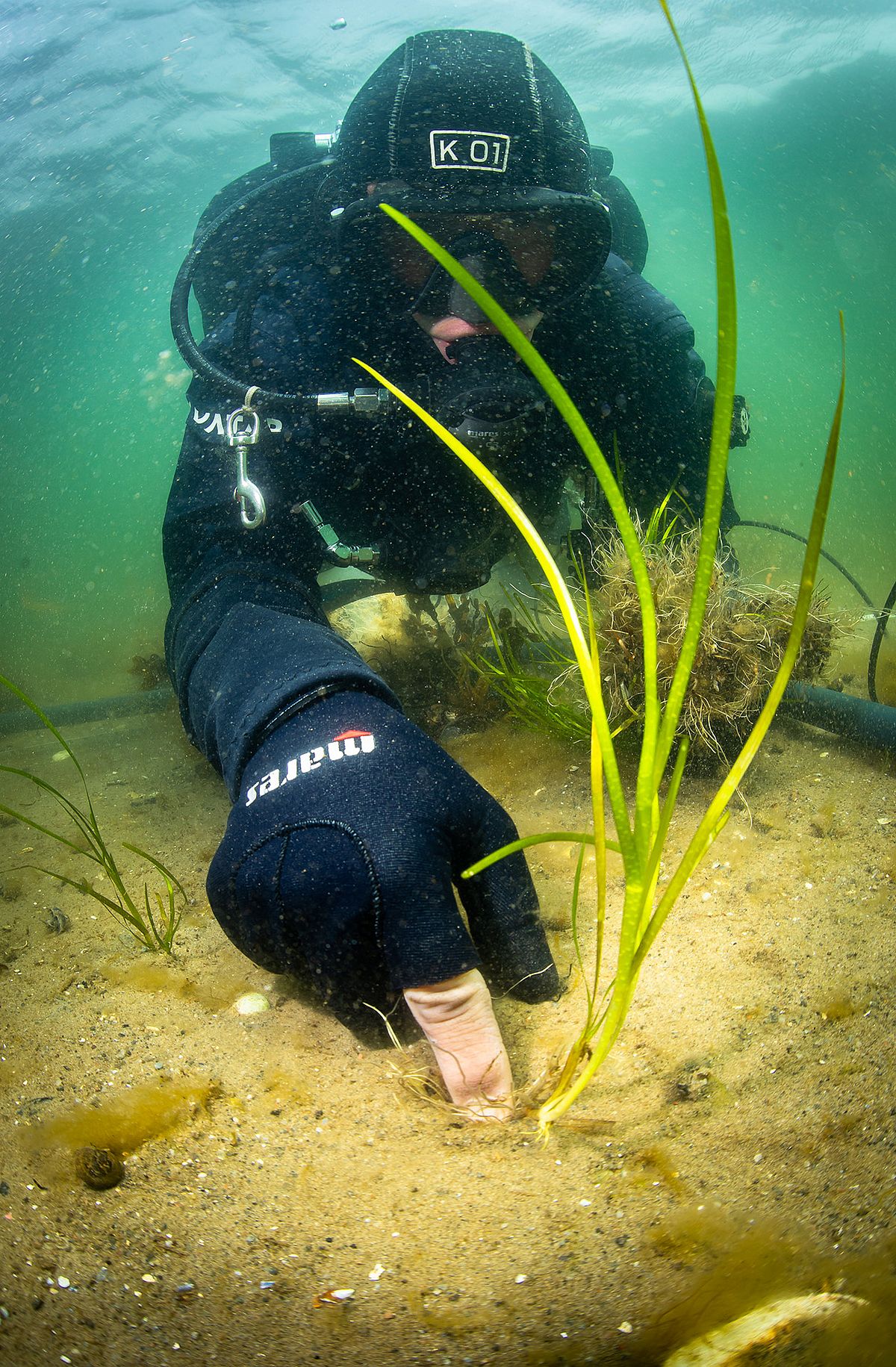Reuters: The Wider Image
In Baltic Sea, citizen divers restore
seagrass to fight climate change
Die Nordreportage: Klimaretter Seegras
The SeaStore project at NDR television
(german)
Seagrass meadows are among the most important marine habitats. They protect the coasts by slowing down waves and holding the sandy substrate with their roots. They provide shelter and food for many marine animals and in this way strengthen the biodiversity of the sea. They can also filter pathogens from the water and help the ocean store carbon dioxide. Yet they are shrinking in many regions of the world. Can this development be stopped?

Research diver planting seagrass. Photo: Christian Howe
Seagrass meadows promote biodiversity and provide important ecosystem services such as carbon sequestration and sediment stabilization, which are of great importance for climate and coastal protection. However, in the past century, the planet has lost at least 30 percent of its seagrass meadows. Reasons for the decline of seagrasses are primarily an excess of nutrients resulting in coastal eutrophication, the increasing use of coastal areas by humans and, to an increasing extent, heat stress in summer.
Current research projects such as SeaStore, in which GEOMAR is also involved, are investigating how seagrass meadows can be restored. The main goal of SeaStore is to create a comprehensive guide for the protection and reintroduction of seagrass meadows in the southern Baltic Sea. This will help to evaluate, plan as well as successfully implement seagrass restoration. The guide cover all aspects of seagrass restoration - from the selection of suitable sites and appropriate seeds or shoots, to specifications on how they should be planted out, to monitoring success and how to incorporate coastal community or tourism interests to increase the chances of success and public acceptance.
In the Kiel Bight, researchers find flowering seagrass meadows along the coast. In summer, the flowering shoots of the seagrass plants develop. They contain seeds, just like plants on land. The seed-bearing shoots are easily harvested by hand. They are easily recognized by the rounded stem, because the leaves of seagrass are flat. The harvested seeds will be used to test seed-based replanting of seagrass meadows as part of the SeaStore project. Video: Sarah Kaehlert/GEOMAR
Seagrass meadows store organic carbon through the production of their below-ground biomass, as well as by filtering out fine organic sediment particles. Their photosynthesis binds CO2 dissolved in the water, which can reduce the amount of man-made CO2 from the atmosphere and store it as "blue carbon" in the sediment for longer periods of time. As part of the Helmholtz Climate Initiative, GEOMAR researched from 2019 to 2021 how much CO2 from the atmosphere the seagrass meadows in the German part of the Baltic Sea store, what contribution they make to the carbon budget in Germany and how the stands can be protected and meadows renatured.
Dr. Angela Stevenson is working on the Seagrass Blue Carbon project. She is a postdoctoral researcher at GEOMAR in the Marine Evolutionary Ecology group in Research Division Marine Ecology, and her work aims to help find solutions to the negative impacts of climate change. Her current research focuses on the ability of seagrass meadows on German coasts to store carbon.
In addition to its ecosystem services, seagrass is also of interest to scientists because it was originally a land plant that was able to adapt evolutionarily back to marine life. Coordinated by the Universities of Groningen and Ghent as well as GEOMAR and with the support of the Cluster of Excellence "The Future Ocean", 20 scientific working groups from nine countries were able to decode the genome of the seagrass Zostera marina in 2016. The team found that numerous adaptations to land life have been lost over the course of its evolutionary history. To the same extent, new genes have appeared as adaptations to life in the sea. As a result, the researchers:in were able to identify gene families that enable pollination underwater and help plants cope with high salinity, low light levels, and altered parasite composition.
In 2023, researchers showed in a publication coordinated at GEOMAR how the seagrass Zostera marina spread from its origin in the northwest Pacific through the Pacific and Atlantic oceans to the Mediterranean Sea. In their analyses, the researchers also found that genetic diversity decreased over the course of the colonization history - which gives rise to the question of how well seagrass can adapt to climate change.
Sea grasses reproduce sexually by forming flowers and seeds. Pollination is carried out by the sea. In addition, the individual plants are also connected in the sediment by root-like, horizontally running rhizomes. These spread laterally in the seabed and conquer new habitat in this way. This is an asexual form of reproduction, also called clonal or vegetative reproduction.
Sexual reproduction produces genetic diversity through recombination and hence, is generally considered a prerequisite for the survival and resilience of species or populations. However, clones that reproduce asexually through branching and fragmentation are the basis of some of the most stable and productive marine ecosystems, such as seagrass beds and coral reefs. In 2020, an international research team led by GEOMAR has shed new light on this apparent paradox. Using seagrass as an example, the study shows that clones are not as genetically homogeneous as assumed. Rather, they can evolve which may be the key to successfully survive in stressful and changing environments.

